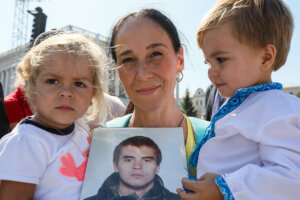On Aug. 29, volunteers who help the Ukrainian army brought 400 sunflowers to a memorial wall in Kyiv to commemorate the Ukrainian soldiers killed in Russia’s war against Ukraine.
Sunflowers have become the unofficial symbol of the battle for Ilovaisk in August 2014, the bloodiest part of the war, when Ukraine lost 366 soldiers, according to the investigation by the Prosecutor General’s Office. Military historians are still arguing about the exact number service killed there.
Aug. 29, 2014 was the day of the heaviest losses. More than 250 soldiers from both the regular army and volunteer battalions were killed by Russian troops, who shelled two Ukrainian military columns that were retreating from encirclement in Ilovaisk city.
The columns were passing through sunflower fields, where the rescue mission would later collect the dead bodies.
Since then, each year the fallen soldiers’ families and friends have come to the memory wall established on the outer walls of St. Michael’s Monastery in Kyiv on this day. As a result, on Aug. 23, President Volodymyr Zelensky signed a decree to make Aug. 29 the official day of remembrance of all those killed in the struggle for Ukraine’s independence and sovereignty.
“This means a lot to me. Now the memory of those killed will be protected,” said historian Tetiana Toropovska, 51, who came to the memory wall with the portrait of a very young man: her dead son.
Georgy Toropovsky was just 17 when he participated in the EuroMaidan Revolution that ousted corrupt President Viktor Yanukovych in February 2014. Then he joined the Kryvbas volunteer battalion, faking his birth year to defend his country from Russia.
Toropovsky survived Ilovaisk. But someone killed him on a train from Kyiv to Dnipro city in September 2014. The police did not find the killers and closed the case. Toropovska said she had no strength to put pressure on investigators back then.
Toropovsky’s story has been depicted in a book, on a postal stamp and in photo exhibitions. Streets in Boryspil city, where he was born, and in Kyiv, where his family now lives, were named after him. He also received an order for bravery post mortem in 2017.
But his mother is still struggling for him to be officially recognized as a soldier killed at war — because he volunteered with a battalion, rather than enrolling through an army recruitment office, and because he faked his year of birth.
Toropovska spoke about this with Oleksandr Danylyuk, the newly appointed secretary of the National Security and Defense Council, who came to the memory wall to talk to the soldiers’ relatives.
Toropovska said there are hundreds of soldiers, living and dead, who fought in the war in the bloodiest periods of 2014-2015 and who still do not have official veteran status. She asked Danylyuk about all of them.
“My son is a powerful figure for heroic memory, but not for official status,” she said.

Tetyana Toropovska stands with her small children during the Independence Day celebrations in Kyiv on Aug. 24, 2019. She holds a portrait of her son Georgy, a EuroMaidan activist and volunteer fighter in Russia’s was, who was killed in 2014. (Volodymyr Petrov)
Tetiana Peretiatko, from Korsun-Shevchenkivsky city in central Ukraine’s Cherkasy Oblast, lost her son Roman Sokurenko, 31, on Aug. 10, 2014, during one of the first attempts by Ukrainian troops to take Ilovaisk.
Sokurenko was a soldier of the Azov volunteer battalion. He was struck in the stomach by a sniper’s bullet and died 44 days later in a German hospital, where he was sent for treatment offered for free by the German government.
Peretiatko now heads a union of soldiers’ mothers in Korsun-Shevchenkivsky and continues sending parcels of homemade food to wounded soldiers in the military hospital in Dnipro.
She came to Kyiv with her son’s portrait and the national flag that he brandished during the EuroMaidan Revolution. Peretiatko couldn’t hold back tears as she showed off the blue-and-yellow Ukrainian flag, which had spots of dirt and the word Korsun written on it.
She also showed the Kyiv Post a text message from her friends in Korsun-Shevchenkivsky, who visited the local cemetery on the Ilovaisk commemoration day to lay flowers on the graves of soldiers killed in Russia’s war. Remembrance ceremonies, both official and unofficial, were held across Ukraine on that day.
According to the text message, they also lit cigarettes and brought some treats the killed soldiers used to love. This is a tradition that has survived in Ukraine since pre-Christian times.
For Sokurenko, Peretiatko’s son, it was a bottle of Pepsi Cola, which they placed by his grave.
“Cola was his favorite drink,” Peretiatko said. “He kept on asking for it all the time while staying at the hospital.”
Text by Oksana Grytsenko
Read more about the Battle of Ilovaisk as the special Kyiv Post project Surviving Ilovaisk
